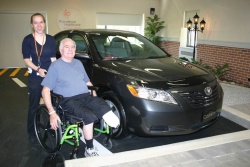 Physiotherapist Julia Filinski and Maurice Woods. Click image to enlarge |
Article and photos by Jil McIntosh
Find this vehicle in Autos’s Classified Ads
Photo Gallery:
Toyota Canada Motor Skills Clinic
Toronto, Ontario – For many people, driving represents freedom of mobility. But for patients at Toronto’s Providence Healthcare, a rehabilitation hospital for those with lower limb amputations, strokes, orthopedic surgery or geriatric-related mobility issues, a Toyota Camry that’s drained of fuel and never turns a wheel is a critical step in teaching patients how to get around.
The Camry sits in the centre of the Toyota Canada Motor Skills Clinic. The large room contains a variety of surfaces which are, except for some artificial grass, all real and full-size: sidewalks with curbs and wheelchair cut-outs, interlocking bricks, cobbled concrete, two sizes of gravel, asphalt with road markings, and a programmable traffic light. The room can also be dimmed and lit to simulate night-time streets. Opened in 2006 through a $300,000 donation from Toyota Canada, the clinic is believed to be the only one of its type in the country, and is popular with physiotherapists and patients alike, who use it as one of the many tools in the rehabilitation process.
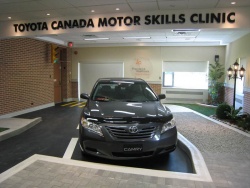 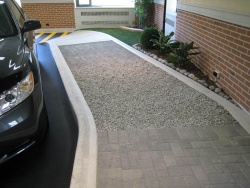 The donated Camry, inside the clinic (top); A variety of surfaces – different sized gravel, and interlocking bring – help patients learn how to get around in unfamiliar places. Click image to enlarge |
“We’d been working (on it) about 18 months before the opening,” said Sandy Di Felice, Toyota Canada’s director of external affairs. “When our engineers were working on a series of innovations around ease of mobility, it was around the same time that Providence came to us and said this is the type of facility we need, and the skills we’d like to teach. The fit was absolutely natural.” The donation covered the cost to build the clinic and its maintenance for the first year; the Camry was an extra gift when the clinic was finished.
If you’re able-bodied, you’ve probably never even thought about how you get into a car. But those who have lost limbs, had artificial joints installed, or who have lost their mobility due to age not only have to think about it, but usually have to learn a whole new method. And while most people don’t think about sidewalk or road surfaces, such variations as gravel or interlocking bricks can be stressful enough for some people with limited mobility that they can actually run the risk of becoming housebound.
“Before we had this space, we would take patients outside to coach them on getting in and out of a car,” said Beth Johnson, Providence Healthcare’s director of communications. “In the dead of winter, or even in summer with the heat, it can be a challenge – the production of having to get dressed, find the car, bring it around. To have an enclosed space has made a huge difference. We had a patient, a stroke victim, who said that without this confidence from learning, they might not go for lunch or for a coffee with a friend. It can trigger a whole chain of events that can change their whole lifestyle.”
As with many rehabilitation hospitals, Providence’s physiotherapists would try to teach patients how to get in and out of vehicles by having them “transfer” from their beds or from chairs as if they were getting in and out of a real car. But that doesn’t allow patients to deal with door openings, handles, dashes and lifting their feet over the door sills, or help patients who simply can’t grasp the concept from the side of a bed. “Some patients have cognitive issues and they need the visual to understand it,” said physiotherapist Julia Filinski. “We have a lot of people with double or single amputations, and their ability to stand isn’t great. Building up their confidence is important.”
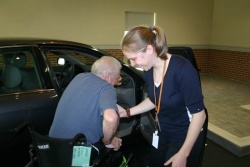 Julia Filinski helps Maurice Woods into the Camry. Click image to enlarge |
The clinic doesn’t actually teach patients how to get back their driving skills – other rehabilitative hospitals in Toronto do that – but it does give them confidence to get in and out of vehicles, no matter what seat they occupy. For Maurice Woods, a former RCMP officer who lost his left leg to complications from diabetes, that left front door is the most important, as he plans to use the techniques learned so that he can get back to driving his Chevrolet Avalanche pickup truck once he’s fitted with an artificial leg and discharged from the hospital.
“I’ve already figured out how I’m going to get in, using the transfer method,” he said. “Once I get up on the running board, I’ll get in and pull myself in. It’s just me, the dog and the truck. We went to the cottage all last summer, and that’s what I’m waiting for now. (The physiotherapists) give me exercises to strengthen my muscles,” he said.
Getting into a chair or onto a bed is relatively easy because they’re level, he said, but there’s a lot more to getting into a car. “You’ve got to stand and turn, and you don’t have a lot to hold onto. You’ve got to know where to grab and push. Instead of going in with my left leg and sitting down, I have to turn my butt around and then swing in.”
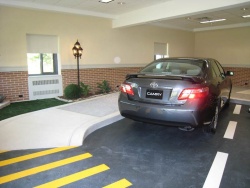 Toyota Canada Motor Skills Clinic. Click image to enlarge |
The fact that the clinic is enclosed makes a huge difference, according to the physiotherapists. Although patients have learned on the sidewalks surrounding the facility in the past, they can be hampered by weather, or simply by nervousness or self-consciousness if they think other patients are watching them. The privacy afforded by the room makes a real difference, Filinski said. “It’s an enclosed environment. Outside, there are ambulances driving up, people driving up. This is quiet, and the patient feels controlled.”
Most patients only require one or two sessions with the vehicle to learn the proper procedures, and family members can come in and learn how to assist in the process. Without being trained themselves, they mean well, but can often make the task more difficult.
When they’re not working with the car, patients also gain valuable training in the various road and sidewalk surfaces. “It’s all outdoor terrain,” said occupational therapist Eva Wong. “When (patients) are in hospital, they’re just walking on a level floor. Here, the walker might catch a little more, or going up or down an incline, people are nervous. We take people walking through all the terrain, or in a wheelchair if they’ll be using one. They need to know how to manoeuvre a wheelchair up and down curbs and through different techniques. The interlocking brick mimics people’s driveways, and they need to know how to walk through it, as a walker might get caught in the cracks. There are traffic lights for people with visual impairment, so we see that they’re going to be able to cross the street safely. And there’s a privacy issue when doing it outside, because people don’t like being watched. It’s respect for the patients to do it in a private environment.”
Johnson said that since the clinic opened in 2006, more than 700 patients have been through it. “The need was there, and the therapists felt that there were challenges associated with taking patients outside,” she said. “The patients need this skill to get home. Once Toyota saw the need, it was an ‘easy sell,’ when they saw how our patients would benefit from it. We feel fortunate to have the relationship with Toyota.”







 Follow Autos on Twitter
Follow Autos on Twitter



